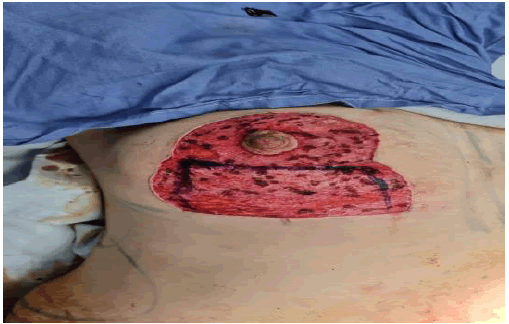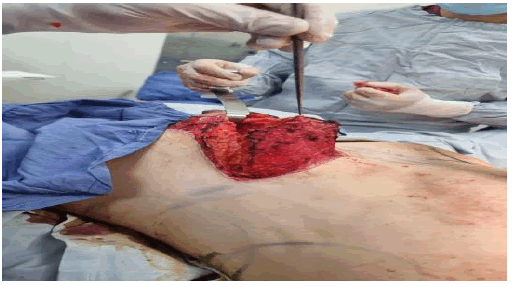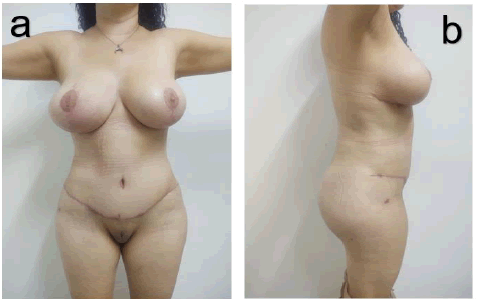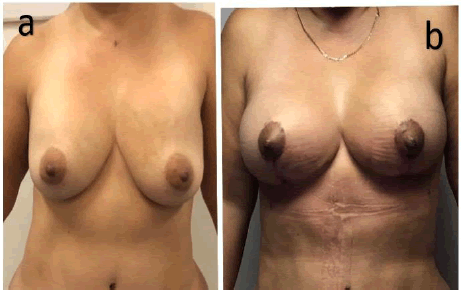Research - (2023) Volume 12, Issue 1
Background: Mastopexies continue to be among the top five surgeries offered by plastic and cosmetic surgery. Mastopexy aims to reposition the Nipple-Areola Complex (NAC) that has descended due to a decrease in the elastic capacity of the tissues and to remodel the remaining breast, by restructuring the glandular tissue and drying the secondary skin surplus. Liacyr Ribeiro's technique has shown satisfactory results, as well as an appropriate versatility for being combined with other techniques. This study aimed to analyze the effectiveness, and aesthetic results of mastopexy using Ribeiro’s technique.
Materials & Methods: A retrospective cohort of 800 patients who underwent Ribeiro’s mastopexy from January 2012 to December 2020 was analyzed.
Results: The patients had different degrees of breast ptosis. The procedure was performed under a peridural block, using the technique described by Liacyr Ribeiro. The patients were monitored for three months, three years, and five years after surgery. During this period, only 5% of the patients presented complications, being C-suture dehiscence the most frequent of all, and only 0.4% developed NAC necrosis. The level of satisfaction among patients was 95%, and none of the complications were related to patients’ history.
Conclusion: We can conclude that the technique described by Liacyr Ribeiro is a surgical procedure with good aesthetic efficacy, which has demonstrated an acceptable percentage of satisfaction in patients who have undergone this technique. The frequency of complications was low, and most of them were generally minor.
Ribeiro mastopexy • Breast ptosis • Droop • Sagging
Aesthetic breast surgery encompasses a spectrum of options, from mastopexy to breast augmentation. The reduction between the skin envelope and breast parenchyma can be approached from the “outside-in” with skin redistribution, from “inside to the outside” with increased parenchyma, or a combination of both. Breasts are a particularly important part of a woman's body and are culturally associated with feminine beauty. However, factors such as pregnancy age provoke the breasts to sag below the inframammary fold, an aesthetic alteration known as ptosis [1, 2]. Breast ptosis is a frequent consultation in the cosmetic surgeon's practice. Breast ptosis is the name given to the disorder of breast shape due to the gradual sagging of the female breast below the submammary fold, which corresponds to the natural crease under the breast. Breast ptosis causes Nipple-Areola Complex (NAC) to be positioned too low, where the breast loses its roundness and becomes oval and sometimes flattened [3]. Mastopexies continue to be among the top five surgeries offered by members of the American Society for Plastic Surgery and have increased sevenfold compared to the 2016 data [4]. Unlike reduction techniques, mastopexy does not involve tissue resection, but tissue redistribution. In the 1960s, Strombeck introduced a technique for breast reduction. However, even if breast volume reduction is not necessary, this technique can be used to redistribute the tissue constitution by following the anatomical landmarks [5]. With this knowledge, in 1971 Dicran Goulian developed a simple and effective mastopexy technique to improve the aesthetic conditions of breast ptosis. In the same year, Lacyr Ribeiro worked on the development of Ribeiro’s technique.
The technique, developed in Brazil by Dr. Lacyr Ribeiro during the 1970s, showed a better aesthetic result and greater tissue safety, and the survival of the NAC. This is because Ribeiro’s technique uses part of the breast tissue, which usually in other techniques is removed from a pyramidal flap (called Ribeiro's pyramidal flap) located on the breast intercostal vessels [6]. Another important consideration for the choice of this technique is the association that has been established in recent years of anaplastic large cell lymphoma with breast implant placement [7], making the Ribeiro type I flap technique an encouraging option for patients who are unwilling to take this risk. Thus, this study aimed to analyze the efficacy of the aesthetic results of mastopexy using Ribeiro’s technique.
An observational longitudinal study was designed to analyze the cosmetic outcomes of Ribeiro’s technique in a retrospective cohort from January 2012 to December 2020. The sample size was calculated using the formula to detect adverse events with known history, with a 95% confidence level (α=0.05), a power of 80%, and a probability of complications (known history) of 6% [2], which gave us a minimum of 595 files to study. For our study, we decided to study 800 randomly selected files, (supported by the SPSS software ver 25 in Spanish) distributed equally in the 8 years of study. All surgeries were performed in a private hospital in the city of Guadalajara, Jalisco, Mexico, by the principal investigator (a physician who specialized in plastic and reconstructive surgery with more than 15 years of experience performing this procedure), who supervised the evolution of the patients. The selection criteria included records of patients diagnosed with breast ptosis (I-IV) who had undergone Ribeiro’s mastopexy surgery.
• Pre-operative assessment: A person-to-person outpatient examination was performed, assessing for inclusion of a NAC dropping of more than 24 cm, with adequate breast volume (minimum B cup) and no desire for breast implants.
• Pre-surgical preparation: All patients underwent blood biometry, 6-element blood chemistry, and evaluation of coagulation times (PT and PTT). If any given patient was taking medications such as aspirin or other NSAIDs, discontinuation was indicated one week before surgery.
•Surgical technique: After asepsis and antisepsis, under a thoracic epidural block, the previously marked skin was de-epithelialized (Figure 1). The marking was performed leaving an incision in the mammary sulcus of approximately 12 cm in length at its base and the highest point at the desired distance from the new NAC, 21 cm from the midclavicular line, and performing the traditional marking of the Wise pattern (Figure 2).
Figure 1: De-epithelialization of breast tissue.
Figure 2: Traditional wise pattern marking.
An incision was made one inch from the NAC, making a plane diaresis up to the pectoralis muscle. The breast was dissected up to the point of highest elevation, i.e. 21 cm in its upper part, and the flap described by Lyacir Ribeiro was cut laterally, leaving the base of the pedicled flap (Figures 3,4). The flap was fixed behind the upper flap carved in the breast and fixed with prolene 1 to the pectoralis fascia, gripping the lower flap to fix it under the upper flap. Finally, the plane was closed with monocryl 3 zeros, resulting in an inverted T-shaped scar (Figures 5a, 5b).

Figure 3: Ribeiro flap.

Figure 4: De-epithelialization of breast tissue.

Figure 5: (A, B). Inverted T-Scar
• Follow-up: Patients were seen one-week post-surgery, 15 days post-surgery, and 3 months post-surgery (Figures 6a, 6b). At each visit, the patient was asked if she was satisfied with the procedure.

Figure 6: (A,B) Comparison of the breasts before and after the procedure.
• Statistical analysis: Data were analyzed with the statistical program SPSS ver 25 in Spanish. Quantitative variables were subjected to normality analysis. An Analysis of variance (ANOVA) with Bonferroni post hoc correction was performed to compare means between groups. The difference between medians was determined with the Wilcoxon test for related variable.
A total of 800 patients were studied over 9 years (2012 to 2020), with an average age of 31 years ± 7 years, a history of weight loss of 9.5 kg ± 3 kg, and median breast ptosis of 3 (q25-q75; 2-4). While 88.5 % of the population treated was originally from Mexico, 11.5% were from the United States of America. Most of the women were housewives (71.1%) and only 10% had a previous pregnancy (Table 1). After analyzing age, degree of ptosis, and months of follow-up, patients were stratified in years, it was observed that in 2014, the patients who underwent surgery were younger than in other years (p=0.002) (Table 2). The patient follow-up was 7 days, 2 weeks, and 3 months after surgery. Pre-surgical NAC value was contrasted with the NAC at 3 months, with a median of 27 (q25-q75; 26-30) and 21 (q25-q75; 20-22) respectively, with a statistically significant decrease in NAC before and after surgery (p=0.000) (Figure 7). Regarding the development of complications, these occurred in 5.1% of the patients who underwent surgery, the most frequent being dehiscence (3.3%), followed by seroma (0.8%) and hematoma (0.4%) (Figure 8). Then, we analyzed different variables to determine if any of them were related to the presence of complications (age, weight loss, degree of ptosis, and initial NAC). None of the variables analyzed showed statistically significant differences between the study groups (Table 3). Finally, an analysis was made of those patients that had undergone revision, three years and five years after surgery (Figure 9). The análisis showed that all the patients preserved their NAC after 3 years, and there was a 1cm-2 cm increase in NAC 5 years after surgery (p=0.000) (Table 4).
Table 1. General characteristics of the women operated with Ribeiro mastopexy.
| N= 800 | |
|---|---|
| AGE (years) | 31 ± 7 |
| Place Of Residence | |
| Mexico | 88.50% |
| United States of America | 11.50% |
| Occupation | |
| Housewife | 71.10% |
| Merchant | 4.40% |
| Employee | 14.80% |
| Professional | 9.80% |
| Previous Pregnancy | 10% |
| Weight Lost Prior to Surgery (Kg) | 9.5 ± 3 |
Table 2. General characteristics of the women who underwent Ribeiro mastopexy (Comparison between study years).
| N= 800 | ||||||||||
|---|---|---|---|---|---|---|---|---|---|---|
|
2012 | 2013 | 2014 | 2015 | 2016 | 2017 | 2018 | 2019 | 2020 | p |
| AGE (years) | 31 ± 6 | 30 ± 5 | 29.5 ± 6* | 29.8 ± 6 | 32 ± 7 | 33 ± 7 | 32.9 ± 7 | 32.6 ± 7 | 32.13 ± 7 | 0.002 |
| DEGREE OF PTOSIS | 3 | 2.9 | 3 | 3 | 2.8 | 2.8 | 2.9 | 2.9 | 3 | 0.567 |
| FOLLOW-UP (months) | 29 ± 17 | 32 ± 16 | 28 ± 17 | 30.2 ± 17 | 18 ± 10 | 21 ± 10 | 12.4 ± 7 | 12.3 ± 6 | 6 ± 3 | 0.664 |
*Comparison among groups was performed with an ANOVA analysis of variance, with Bonferroni post hoc correction * Groups that showed significant differences respect to. |
||||||||||
Figure 7: Comparison between initial NAC and final NAC (Three months follow-up).
Figure 8: Frequency and types of complications following Ribeiro type mastopexy
Table 3. Comparison of risk characteristics between patients who developed a complication and those who did not.
| N= 800 | ||||
|---|---|---|---|---|
| Complications | Without Complications | p | ||
| n= 41 | n= 759 | |||
| AGE (years)* | 31.7 ± 6 | 31.6 ± 6 | 0.929 | |
| Lost weight (Kg)* | 9.5 ± 3 | 9.56 ± 3 | 0.438 | |
| Degree of ptosis ** | 3 (2 - 3) | 3 (2 - 4) | 0.533 | |
| Initial NAC** | 27 (26 - 30) | 27 (26 - 30) | 0.611 | |
| * Data is presented as mean and standard deviation, comparison between them was performed with Student's t-test. ** Data is presented as median (q25-275), the comparison was made with Mann Whitney U test. |
||||
Figure 9: Frequency and type of complications following ribeiro type mastopexy.
Table 4. Assessment of the nipple-areola complex pre-surgery and follow-up at 3 months, 3 years and 5 years.
| N= 800 | ||||||
|---|---|---|---|---|---|---|
| Before Surgery | 3 months* | 3 years | 5 years* | p | ||
| n=800 | n=800 | n=60 | n= 12 | |||
| NAC (cm) | 27 (26-30) | 21 (20-22) | 21 (20-22) | 21 (21-23) | 0 | |
| The comparison among groups was performed with an ANOVA analysis of variance, with Bonferroni post hoc correction. *Groups that showed p values ≤ 0.05. | ||||||
Mastopexy aims to replace the NAC that has descended due to a decrease in the elastic capacity of the tissues and to reshape the remaining breast by restructuring the glandular tissue and resecting the secondary cutaneous excess. Moya-Rosa et al analyzed a longitudinal cohort of 24 patients, with similar characteristics to those presented by our study population; the majority of their patients had grade III breast ptosis at ages ranging from 28 to 37 years [2]. Breasts sag by gravity, conditioned by common processes in a woman’s life such as lactation, variations in body weight, the tendency to tissue laxity, and senescence [8]. Moya et al [2] detected a significant history of pregnancy, lactation, and massive weight loss (83%, 80%, and 66.6%, respectively). In our study, only 10% of the women reported previous pregnancies, while weight loss ranged from 9.5 kg ± 3 kg. In this regard, Wolter et al conducted a retrospective study analyzing 136 women with massive weight loss who underwent Ribeiro’s mastopexy [9]. The average age of their patients was 41 years with an average weight loss of 9.5 kg and a NAC of 32 cm. In the studies of Moya et al [2] and Wolter et al [9], 95% of the patients rated mastopexy as very satisfactory. Camara et al reported two clinical cases with a diagnosis of multiple bilateral fibroadenomas, whose surgical approach was performed with Ribeiro’s technique modified by Rezai [10]. Of the four breasts operated by Camara et al more than 70 fibroadenomas were removed. The cosmetic results after a 4-year follow-up were very satisfactory. One of the advantages subscribed by Camara to justify the use of Ribeiro’s technique was the low frequency of complications in a relatively simple technique, and the fact that it can be used in combination with other techniques. The complication frequency detected in our study was 5% with no variation during all the follow-ups, which suggests that good results can be achieved regardless of the surgeon's experience.
Regarding the correction of the NAC, we observed that our patients were admitted to surgery with a nac ranging between 26 cm and 30 cm, and at the postoperative follow-up after three months they were re-evaluated and obtained a NAC of 21 cm (20 cm -22 cm). Thus, we propose that Ribeiro's technique is a promising alternative for candidates who do not have the possibility of receiving an implant or do not wish to have one placed. Like Moya et al [2], Camara et al [10], and Wolter et al [9], the results of these interventions had a rate of 95% of complete patient satisfaction. On the other hand, of the 5% of patients that presented complications, only 2.5% required reoperation.
Wolter et al reported in 2017 the analysis of a retrospective cohort of 294 mammoplasties in patients diagnosed with gigantomastia who underwent mastopexy with Ribeiro’s technique [11]. In each case, an amount greater than 1,000 g of tissue per breast was resected, in an age range of 18 years-74 years, and a body mass index of 19 kg/m2-40 kg/m2. The most frequent minor complications were those related to scarring (3.1%), partial necrosis of the NAC 0.3% (0.3%), and infections (0.7%), while the most frequent major complication was complete necrosis of the NAC (3.1%). In our study, the most frequent complication was C-suture dehiscence (3.3%), followed by seroma (0.8%), and hematoma (0.4%), while only 0.4% had NAC necrosis.
Based on our data, we conclude that the technique described by Liacyr Ribeiro is a surgical procedure with great aesthetic efficacy, which has demonstrated a high percentage of satisfaction in patients who have undergone this technique. The frequency of complications is low and most of them were minor. The Ribeiro technique is an excellent option, which provides the versatility required by the cosmetic surgeon and can even be used safely in inexperienced surgeons given the anatomical conditions of the type I flap. Finally, the application of a technique that offers encouraging results, without requiring the use of implants, reduces the likelihood of longterm complications arising from the use of implants.
• The authors declare that they have no conflicts of interest to disclose.
• This article does not contain any studies with human participants or animals performed by any of the authors. This is a retrospective study with a careful review of the files.
• A signed informed consent was obtained from all the members of the cohort. Likewise, we have the authorization to use and present the data obtained, as well as the photographs exhibited in this article.
• The authors declare that they did not receive any type of financing from any institution.
[Google scholar] [Cross ref]
Citation: Trejo, H.A., et al. Aesthetic Efficacy of Ribeiro�´s Mastopexy. Analysis of a Cohort of 800 Patients. Reconstr Surg Anaplastol. 2023, 12(1), 001-004.
Received: 07-Jan-2023, Manuscript No. ACR-23-22725; Editor assigned: 09-Jan-2023, Pre QC No. ACR-23- 22725(PQ); Reviewed: 19-Jan-2023, QC No. ACR-23-22725(Q); Revised: 23-Jan-2023, Manuscript No. ACR-23- 22725(R); Published: 30-Jan-2023, DOI: 10.37532/acr.23.12.1.001-004
Copyright: © 2023 Trejo, H.A. This is an open-access article distributed under the terms of the Creative Commons Attribution License CC-BY, which permits unrestricted use, distribution, and reproduction in any medium, provided the original author and source are credited.